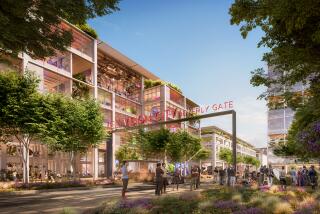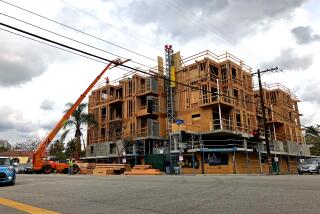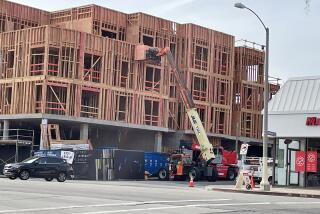Council Adopts General Plan for 20-Year Growth
- Share via
PASADENA — Ultimately, everybody agreed Tuesday on the sweeping generalizations about creating “a greater city.” It was the minutia of city planning that had them griping.
After five hours of horse-trading and debate, the City Council finally approved a new Draft General Plan, setting the city on a 20-year path designed for managed growth, healthy businesses, fewer cars on the streets, preserved historic structures and the like.
The plan, which now goes to the state office of planning for review, also tackles a number of neighborhood specifics, such as spillover freeway traffic on Corson Street and the prospect of a Home Depot store in east Pasadena.
Lurking in the background during the discussion was the city’s 3-year-old Growth Management Initiative, which placed annual limits of 250,000 square feet of new commercial space and 250 units of new housing.
Council members have posed the revised General Plan as a substitute for the GMI, which goes before the voters once again in November. A 1990 lawsuit, initiated by businesses and minority groups, challenged the GMI’s constitutionality, claiming that it was stifling the commercial life of the city.
In an out-of-court settlement, the city agreed to update the “land use” and “mobility” elements of the General Plan, getting thousands of residents involved in setting long-range development and traffic goals, and to put the GMI back on the ballot in November.
“We’re writing a political document,” said Councilman William Thomson, acknowledging the high-stakes gamble of pitting the General Plan against the GMI.
Neighborhood groups have not hesitated to use their votes to bargain for concessions. For example, residents of Corson and Maple streets objected Tuesday to the use of their streets as a “smart mobility corridor” to handle traffic slowdowns on a nearby freeway.
“How would you like it if they planned a corridor in front of your house?” said Corson resident Ernesto Ruiz, who complained that traffic is already bad on streets that run parallel to the Foothill Freeway.
Ruiz and a group of neighbors said their support for overturning the GMI was conditioned on the elimination of the traffic corridor.
“Without deleting the corridor,” said Councilman William Paparian, “there will be no support for what we have on the ballot in November.”
“That’s right!” shouted some members of the audience.
The residents lost that one, as the council voted to retain the proposal. The corridor--along which signs will be posted directing motorists to freeway entrances--would benefit the entire city by better managing traffic, council members said.
“The 200,000 cars which come through the city every day (on the freeway) can’t be wished away by my saying, ‘I want their support in November,’ ” Mayor Rick Cole said.
But other neighborhood concerns were written into the plan at the last moment. A proposal to beef up the Hastings Ranch Shopping Center--the “Sears Center”--with 250,000 square feet of new commercial space and a parking structure was pared down to a modest 25,000 square feet.
“This is a make-or-break issue for that neighborhood,” said Paparian, who represents the Hastings Ranch area.
In the same neighborhood, plans for “big box” commercial projects, such as a proposed Home Depot outlet on Foothill Boulevard, were also set back as the council hashed out an agreement to encourage the development of light industry in a triangular area between Foothill, Rosemead Boulevard and Sierra Madre Villa.
Residents had objected to heavy infusions of traffic that stores like Home Depot would create, and members of the council pushed for bringing in manufacturing jobs.
Councilman Jess Hughston supported attracting new retail outlets, and new sales tax revenue, to the city.
“Because of the California (business) climate, industries are moving out of the state, as well as out of Pasadena,” Hughston said. “Perhaps under a different governor, in a different millennium, this will work.”
Cole and Thomson pressed for a proposed “environmental park,” a complex of businesses specializing in improving the environment.
Finally, the council worked out a compromise, reserving the property for light industry until 1994, to give city planners and businessmen a fair chance to advance the idea.
“Let’s not lock up the property for 10 years,” Thomson said.
The unanimous vote in favor of the plan, with five of seven council members present when the vote was taken shortly before midnight Tuesday, ended an 11-month city effort to involve residents in long-range planning. Some 2,700 Pasadenans from all walks of life participated in the process, city officials said.
Councilwoman Kathryn Nack conceded that the final document was shaped by political issues.
“But, in my opinion, it does protect neighborhoods,” she said. “Parts of the plan don’t satisfy this person or that person. In my opinion, it’s a good blueprint.”
Since the planning process began last year, many in the city have sacrificed their limited interests for the greater good of the city, Cole said.
“I think we’ve come a hell of a long way toward getting people to see the overall good of the city as a bigger stake than just protecting their property interests,” the mayor said.
Once the Draft General Plan gains state approval, the city will prepare an environmental impact report. The final General Plan will be voted on by the council within two years. In the interim, the council will revise the zoning code to conform to the plan.
More to Read
Sign up for Essential California
The most important California stories and recommendations in your inbox every morning.
You may occasionally receive promotional content from the Los Angeles Times.










